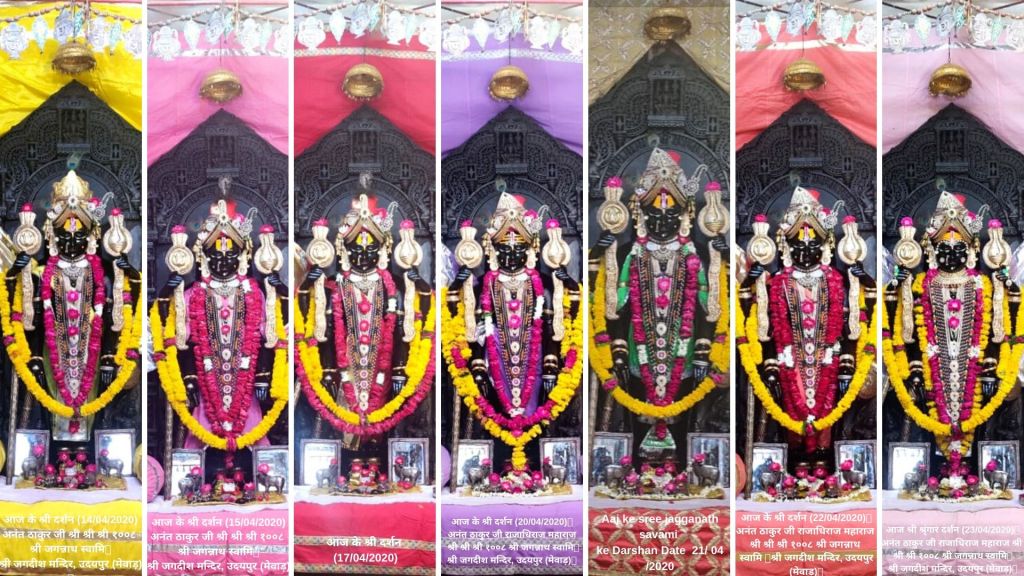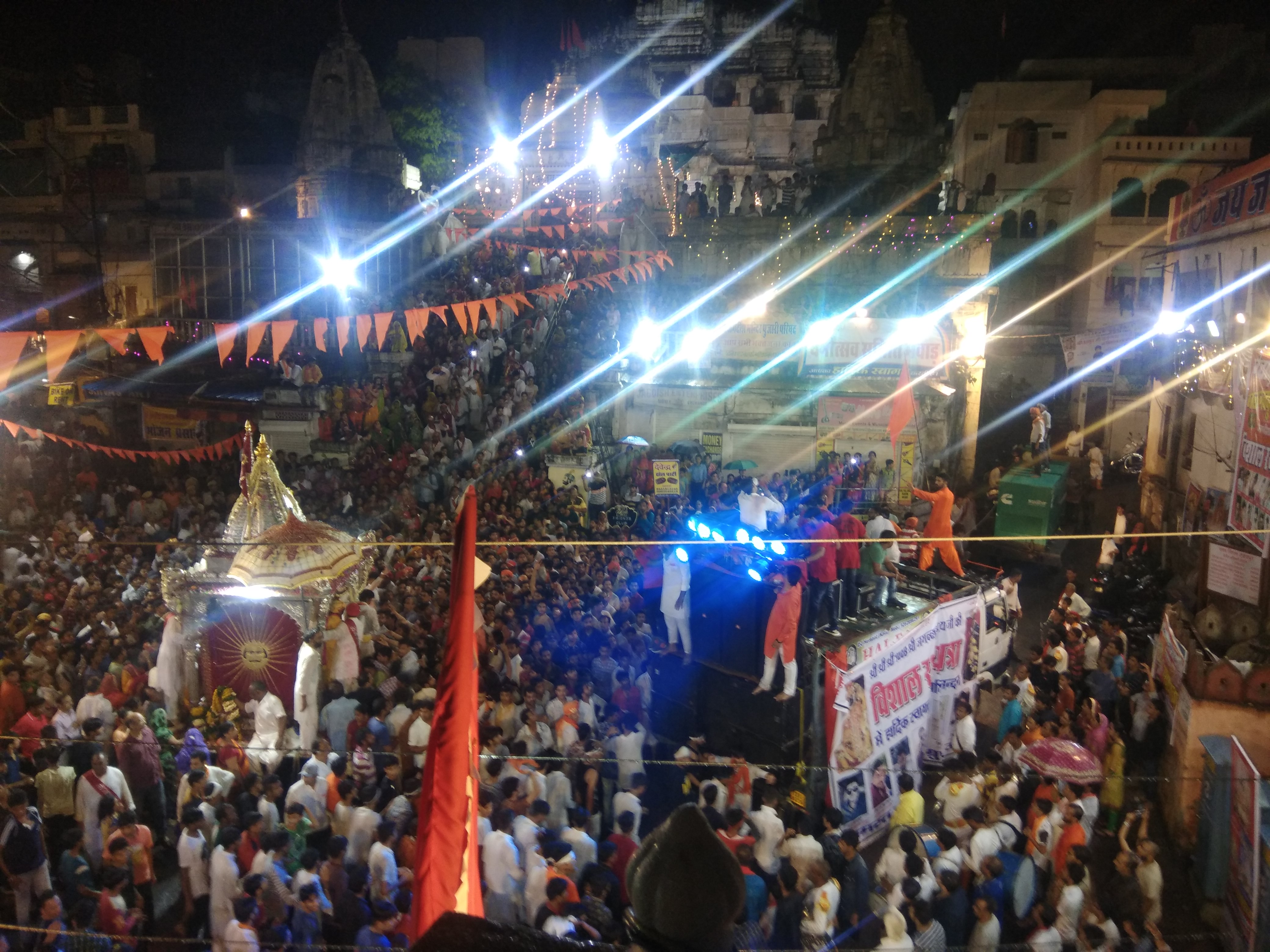(Names have not been changed in this summary)
Ashok ji is one of the many pujaris of Udaipur’s famous Jagdish mandir. Built by Maharana Jagat Singhji I, the construction of Jagdish mandir began in 1622 and was completed in 1652. The Maharana selected a pujari to do puja archana in the mandir, and this responsibility has been passed on from one generation of the pujari’s family to another. Today, four families, all descendants of the pujari first chosen by Maharana Jagat Singhji I, conduct puja archana in the mandir.
Following a system put in place by their ancestors, the four families take turns to do puja for one month at a time. The cycle continues throughout the year and as their ancestors arranged it, the mandir’s major festivals are distributed equally across each family’s turns in the cycle, meaning that responsibilities and opportunities to collect daana are divided equally.
In normal circumstances, considering that Jagdish mandir is the largest Vishnu mandir in North India and also a major tourist attraction, awaa gaman toh bahut hi rehta hai na, bheed toh rehti hai. Din mein 1000-1500 log toh aate hein. Hare Rama, Hare Krishna (ISKCON) people also come to the mandir and do puja according to their paddhati. They bring a lamba dholak, dance, and sing bhajans.
Holi has recently gone by. The last holi celebration in Jagdish mandir, rang pancham, happened before the lockdown and was celebrated as per custom. The tradition is to go to Eklingji on the following teras. Bhajan mandalis, many bhakts, they all go to Eklingji. Arrangements are made there for food and so on and people visit in large numbers. With rang teras in Eklingji holi ke parv samapt ho jaate hein. But this year, by teras the lockdown had already began.
Rath yatra and nirjala ekadashi are coming, they are Jagdish mandir’s biggest festivals. The rath yatra taken out from Jagdish mandir is second only to the one in Puri. This year it will fall on 23rd June. 15 days before that is nirjala ekadashi, during which people fast for 24 hours without drinking even a sip of water. It is a festival of daan punya. The administration puts up tents in Jagdish chowk, where the mandir’s steps begin, and coolers are installed for the public. People begin lining up for darshan from 5 in the morning. There is police presence for crowd control. Darshan continues until midnight. This year it is uncertain if these festivals will be celebrated. Ashok ji expects they will be cancelled.
Jagdish Manav Seva Samiti, which is associated with the mandir, runs an anna kshetra or community kitchen in an adjoining premises. They collect money through donations and serve food to about 500-1000 needy people everyday. The kitchen is functioning during the lockdown. Kitchen staff is maintaining distance and taking precautions to keep themselves and others safe. Lockdown ke hisaab se public wahaan pe nahi jeem rahi hai abhi. Jagdish chowk ke jitne bhi mitra mandal hein na, mewar sena, yuva morcha and so on, who also organise garba programmes in Jagdish chowk during navratri, together they are identifying the zarooratmund and distributing food packets mohalla wise. These groups have taken the necessary persmissions. Unke pass bane hue hein police prashasan se, muh pe mask bandh kar ke nikal rahe hein. Except for them no one is really allowed to move around. In the mandir, pujaris, safai karamcharis, everyone is following the guidelines of the government, to keep washing hands and cover their mouth with a mask or rumaal. Ashok ji also wears a rumaal when he goes to the mandir, he wears it while doing puja as well. Recently, media outlets like Mewar channel, India TV, and Aaj tak had come to the mandir to cover how it is operating during the lockdown.

Usually about 10-15 sadhu sanyaasis are always sitting on the steps of the mandir. Some of them live here and there closeby and come to the madir early in the morning. Whatever they get as daan-punya, ussi mein unka gujar-basar karte hein woh. At night, several sleep around the mandir itself. But at the moment there are only 2-4 sadhu sanyasis at the madir steps. The rest have gone idhar udhar, apne gaaon ki taraf. In normal circumstances 100-300 sadhu sanyaasis would eat at the anna kshetra next to the mandir everyday.
Before the lockdown several people came to the temple regularly. They would come for darshan, for bhajan sandhyas, to sit together, and so on. Now they feel ki ye din kaise aa gaye hein ki bhagwaan se bhi duri ho gayi apni. Unko bhi bahut akelapan mehsus ho raha hai. Ashok ji and other pujaris try to give them bhagwaan ke darshan by sharing photos on WhatsApp.
There is a lot of police presence in Jagdish chowk. Police vehicles come often to the area and make announcements about remaining at home and not gathering in groups. Roads and public places are sanitized regularly. About 2 weeks ago, a few cases of Covid-19 were detected in Malla Talai, which is beyond Jagdish chowk and towards Chand Pol. The entire area was sealed off and movement in and out was completely stopped. They began to slowly relax the curfew there only about 2-3 days ago. In Ashok ji’s area doctors and nurses have come door to door asking if anyone has symptoms like cough or fever, or if anyone in the house has recently come from Bhilwara district, Maharashtra, or MP. These medical teams were wearing gloves and masks, and those who had symptoms were asked to accompany them for testing. As such there isn’t much tension in Udaipur since number of cases isn’t that high.

PC: Ashok ji
Udaipur has one of the largest public hospitals in Rajasthan, the Maharana Bhupal Govt. Hospital. It is well-known across Rajasthan and in other states as well. Yahaan toh bahut achhi suvidhayein hein, doctors bhi achhe hein. In the hospital they have created a separate ward for corona patients, like they had created for swine flu. All corona patients are properly isolated.
Even so, dar toh lagta hi hai, dar kyun nahi lagega. This disease is spreading all over the world, there is a problem all over the world. Confined in his home, Ashokji prays that no one should get this disease. Vasudhaiva kutumbakam, ek parivaar ki tarah, sabko bimaari se mukt rakhhe, bhagwaan sabka bhala kare.
Before the lockdown, Ashok ji would wake up early in the morning, go to the mandir, seva puja karke he would get ready to go to the office where he works. He would prepare tiffin, get the children ready, wahi routine ka kaam rehta tha. Now ghar mein sab kaid ho gaye. But thoda bahut they are able to go out of the house to the mandir.
With the lockdown underway, both gates of the mandir are closed. In its 450-year-old history, it has never been closed to the public in this way. Humare buzurg log bhi bolte hein ki humne bhi kati aisa nahi suna ke mandir ke patdwaar band hue hon. Even when some similar circumstances have arisen in the past, darshan ke liye mandir ka band hona, aisa kabhi nahi hua hai. This is the first time it is happening. Humein bhi bahut atpata lag raha hai. Soona pan bhi hai. Mandir bhi band, sabse duri banake rakhna, bahar bhi nahi nikal sakte zyaada, kisi se baat nahi kar sakte. Lekin kya karo, jitna sarkar ka nirdesh hai, saara manna toh padega hi.
The pujari parishad of Jagdish mandir, in which each pujari has a place, looks after the maintenance and running of the mandir. It organises all festivities that take place within the mandir parisar, like holi, janmashtami, saavan jhula, the first part of rath yatra, in which a small rath is taken out within the mandir premises itself, and so on. The government and bhakts across the city put together the grand festivities that take place outside the mandir, such as preparations in the chowk for nirjala ekadashi and the second part of rath yatra, during which an elaborate rath accompanied by several jhankis progresses into the city with much fanfare.
Pujaris have no fixed monthly income. They collect whatever is placed in the pooja thaali by darshanaarthis. The closure of Jagdish mandir to the public has impacted Ashok ji’s family significantly. Humara toh parivaar isi pe tika hua hai. Everyone in the family is involved in puja at the mandir, and they are wholly dependent on it for their income. The income from other employments is very low. But bhagwaan ki krupa hai that they are quite alright and are not facing any dire straits.
People cannot come inside, but within the mandir complex, the work of the pujaris continues. Bhagwaan ki puja archana woh toh vidhivats chal hi rahi hai. Every day at 5:30 am the mandir opens, bhagwaan ka snaan karke 9:30 ko shrungaar aarti hoti hai. Bhagwaan ko ek ghante ka bhog lagta hai aur 11:30 ko bhog aarti hoti hai. The mandir is closed between 2:30 and 4 in the afternoon. Saayankal 7 baje sandhya aarti hoti hai, last mein, 9:45 shayan aarti hoti hai. Then the mandir is closed again. Prasad ban raha hai, bhog bhi lag raha hai, sab kuch chal raha hai. The prasad is made in lesser quantities now, enough only for the guards and safai karamcharis.
Jo parampara hai woh toh chal hi rahi hai. The only difference is, there are no darshanaarthis.
Article by: Garima Raghuvanshy
![Pujari Ashok Ji [Jagdish Temple]](https://udaipurblog.com/wp-content/uploads/2018/03/Jagdish-Temple-600x450.jpg)




